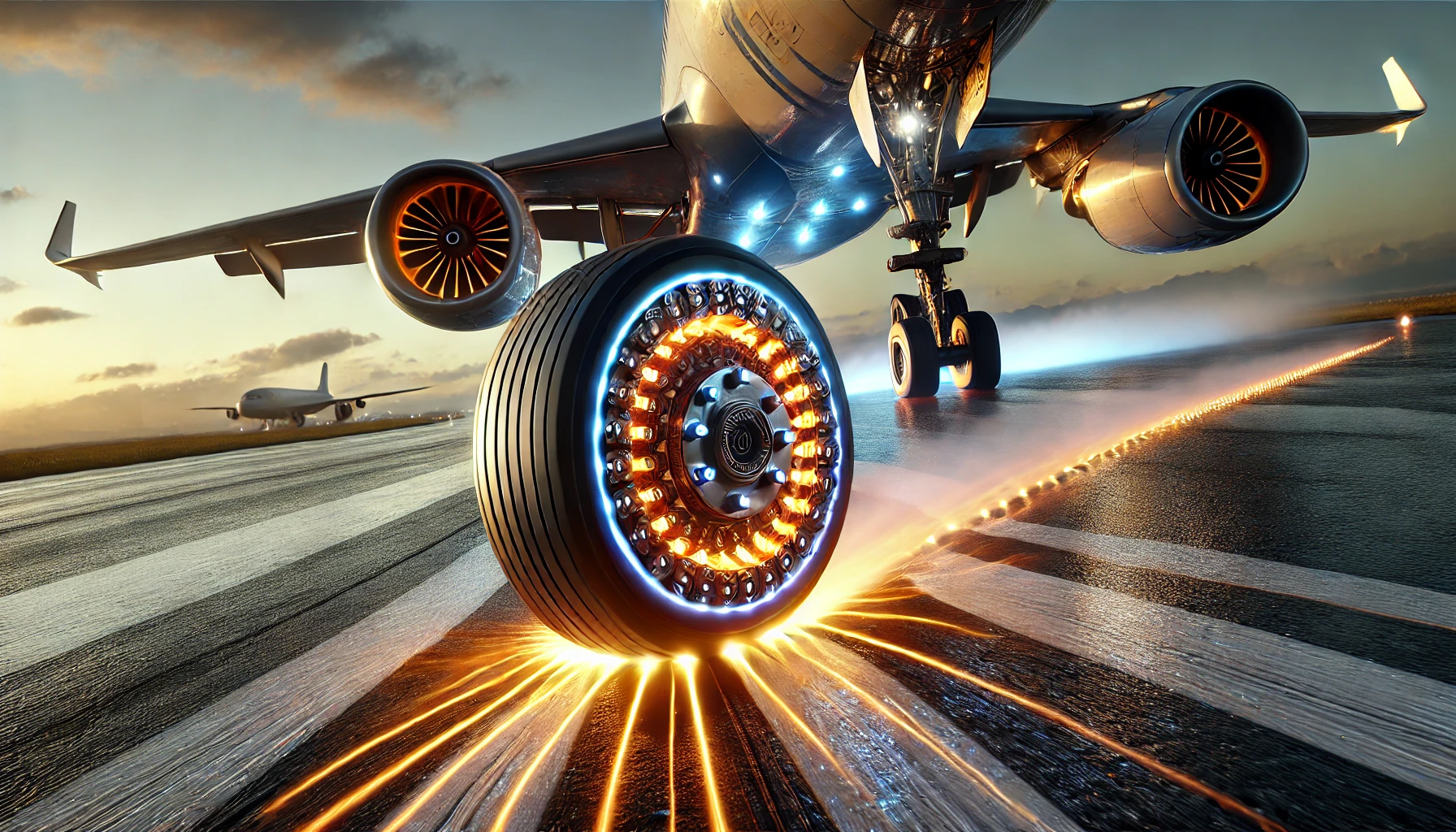Welcome aboard as we take you on an exhilarating journey through the intricate world of aircraft braking systems! When it comes to aviation, safety and precision are paramount, and perhaps no component embodies this better than the brakes. From the moment a plane touches down on the runway to when it smoothly taxis to a stop, these engineering marvels work tirelessly behind the scenes.
In this deep dive, we’ll explore how different braking systems operate, their vital functions in ensuring safe landings, and the innovative variations that keep our skies secure. Whether you’re an aviation enthusiast or just curious about what keeps these colossal machines grounded, fasten your seatbelt—this blog post promises to provide insights that will leave you soaring with knowledge!
Introduction to Aircraft Braking Systems
Aircraft braking systems are often an overlooked yet critical component of aviation safety and efficiency. When we think about flying, our minds tend to wander to the majesty of soaring through the skies or the complexity of navigation. However, behind every smooth landing lies a sophisticated network of brakes designed to ensure that aircraft can stop safely and effectively.
From commercial airliners carrying hundreds of passengers to private jets whisking business executives across continents, understanding how these braking systems work is essential for anyone interested in aviation. As technology advances and aircraft become faster and heavier, so too does the need for innovative braking solutions.
Join us as we explore the various types of aircraft brakes, their functions, and what makes them crucial in ensuring safe takeoffs and landings. Whether you’re an aviation enthusiast or simply curious about how planes manage speed on those long runways, there’s plenty to uncover about this vital aspect of flight operations. Let’s dive deep into the world of aircraft brakes!
Importance of Brakes in Aircraft
Brakes play a crucial role in aircraft safety and functionality. Their primary job is to slow down or stop an aircraft during landing, taxiing, and emergency situations. The effectiveness of brakes directly impacts the pilot’s control over the plane.
Without reliable braking systems, even minor issues could escalate into serious accidents. Pilots depend on efficient brakes to maneuver safely on runways and ground surfaces after touchdown.
Properly functioning brakes help ensure that the aircraft can handle varying speeds while maintaining stability. This becomes especially vital under challenging conditions like wet or icy runways.
Furthermore, advanced brake technology enhances overall operational performance. It allows for precise control during landings, which is critical when approaching congested airports with tight schedules.
The importance of robust braking systems cannot be overstated; they are essential for safe air travel worldwide.
Types of Aircraft Brakes:
Aircraft braking systems come in various types, each designed for specific operational needs.
Mechanical brakes rely on physical components such as levers and linkages. They are simple yet effective, often found in smaller aircraft.
Hydraulic brakes use fluid pressure to amplify force. This design allows for smoother operation and is widely used in commercial airliners.
Electromechanical brakes integrate electrical systems with traditional mechanics. These offer precise control and quicker response times, making them ideal for modern aviation demands.
Carbon-carbon brakes have gained popularity due to their lightweight nature and superior heat resistance. They perform exceptionally well during high-speed landings.
Each type serves a unique purpose, contributing significantly to an aircraft’s safety and efficiency while landing or taxiing on the runway.
Mechanical Brakes
Mechanical brakes are one of the oldest types of braking systems used in aircraft. They rely on physical components, such as levers and cables, to create friction that slows down or stops the aircraft.
These brakes operate through a simple mechanism. When a pilot presses the brake pedals, it engages a series of linkages. This action tightens the brake pads against the wheels, generating resistance.
Despite their simplicity, mechanical brakes can be highly effective for smaller aircraft and certain aviation applications. They offer reliability due to fewer complex components compared to modern systems.
However, mechanical brakes can require more effort from pilots during operation. This can lead to fatigue over long flights or repeated landings.
Maintenance is crucial for these systems. Regular inspections ensure they remain functional and safe throughout an aircraft’s operational life.

Hydraulic Brakes
Hydraulic brakes are a critical component in modern aircraft, providing reliable stopping power when it’s needed most. These systems utilize fluid mechanics to transfer force from the pilot’s input at the control yoke or pedals directly to the braking mechanism.
When the pilot applies pressure on the brake pedal, hydraulic fluid is forced through lines to activate pistons located in each wheel assembly. This action compresses brake pads against rotors, generating friction that slows down or halts the aircraft’s motion.
One of the key advantages of hydraulic brakes is their ability to provide consistent performance under various conditions. They also require less physical effort from pilots compared to mechanical systems.
Designed for high efficiency and durability, hydraulic brakes can handle significant thermal loads during landing and taxiing phases, ensuring safety without compromise. Their design minimizes wear and maintenance needs while maximizing operational reliability across a range of aircraft types.
Electromechanical Brakes
Electromechanical brakes represent a modern solution in aircraft braking technology. These systems harness electric actuators to engage the brake components, replacing traditional hydraulic mechanisms.
The core advantage lies in their precision and responsiveness. By utilizing electronics, pilots can achieve finer control when slowing down or coming to a stop. This allows for smoother landings and reduced wear on tire surfaces.
Moreover, electromechanical brakes are often lighter than their hydraulic counterparts. This reduction in weight contributes positively to overall fuel efficiency—a significant consideration for airlines today.
Maintenance of these systems is also streamlined due to fewer moving parts compared to mechanical brakes. As technology advances, expect electromechanical options to become more prevalent across various aircraft types. The shift towards electrification is transforming how aircraft manage speed and safety during operations on tarmacs worldwide.
Carbon-Carbon Brakes
Carbon-carbon brakes are a marvel of modern engineering. They consist of carbon fibers reinforced with carbon matrix, which makes them incredibly lightweight yet strong. This unique composition allows for high thermal resistance, making them ideal for aviation.
When subjected to extreme temperatures during landing and takeoff, these brakes perform exceptionally well. Unlike traditional metal brakes that can warp or degrade under heat stress, carbon-carbon maintains its integrity. This durability translates into improved safety and performance.
Moreover, the weight savings associated with carbon-carbon technology contribute to overall fuel efficiency in aircraft design. Airlines appreciate this not only for operational cost savings but also for environmental benefits.
These advanced braking systems have become standard on many high-performance jets and commercial airliners due to their reliability and effectiveness under various conditions. The shift towards incorporating such innovative materials is reshaping the future of aviation brake systems significantly.
How Do Aircraft Brakes Work?
Aircraft brakes operate through a combination of mechanical and hydraulic principles. When the pilot applies pressure to the brake pedals, this force is transmitted to the brake system.
In most aircraft, hydraulic fluid flows into calipers that grip the brake discs. This process generates friction, which slows down or stops the aircraft effectively.
The braking force can be adjusted based on needs—light for taxiing or more robust during landing. Advanced systems also incorporate anti-skid technology, preventing wheel lock-up and enhancing control.
Temperature plays a critical role in performance too; as brakes heat up from repeated use, their effectiveness may change. Understanding these dynamics ensures safe landings and smooth operations in various conditions.
Factors Affecting Brake Performance:
Several factors play a crucial role in determining brake performance. The weight and speed of the aircraft are significant variables. Heavier planes require more powerful braking systems to ensure effective deceleration.
Runway conditions can greatly affect how brakes respond. Wet, icy, or uneven surfaces may lead to reduced friction and longer stopping distances. Pilots must adapt their approach based on these conditions.
Temperature also influences brake functionality. High temperatures from frequent landings can cause brake fade, leading to diminished effectiveness when they’re needed most.
Altitude is another consideration; thinner air at higher elevations affects engine performance and could influence braking dynamics during landing phases. Each factor intertwines, making it essential for pilots and engineers alike to stay aware of these elements for safe operations.
Weight and Speed of the Aircraft
The weight of an aircraft directly influences its braking requirements. Heavier planes demand more robust braking systems to create the necessary friction and force for safe landings. Each pound adds pressure on the brakes, impacting their performance.
Speed is another critical factor. As an aircraft descends toward the runway, its velocity increases dramatically. The faster it travels, the harder it becomes to stop effectively. Higher speeds require enhanced brake efficiency to ensure a timely halt without excessive wear or heat buildup.
Engineers meticulously calculate these variables when designing braking systems. They strive for a balance between weight and speed to optimize safety and control during landing operations. Understanding this relationship is essential for maintaining effective operational standards in aviation technology.
Runway Conditions
Runway conditions play a crucial role in aircraft braking performance. Factors like surface texture and moisture can significantly affect how well brakes engage.
A dry, clean runway provides optimal traction. In contrast, wet or icy surfaces increase the risk of skidding. Pilots must adjust their approach based on these variables to ensure safe landings.
Contaminants such as snow, ice, or debris can hamper brake efficiency. Aircraft systems are designed with this variability in mind but require pilots to stay vigilant.
Additionally, runway length matters. Shorter runways necessitate quicker stopping distances, placing greater demands on braking systems under less-than-ideal conditions.
Understanding these dynamics helps enhance safety measures and informs maintenance schedules for both pilots and ground crews alike. Each landing is unique, making awareness of runway conditions essential for effective operation and safety considerations during flight.
Temperature and Altitude
Temperature and altitude play significant roles in the performance of aircraft brakes. As an aircraft ascends, the air thins out, leading to changes in pressure that can affect braking efficiency.
High temperatures also impact brake systems. When brakes are applied during landing or taxiing, they generate heat. Excessive heat can lead to brake fade, where the effectiveness diminishes due to overheating components.
At higher altitudes, lower ambient temperatures can provide cooler conditions for braking systems. However, this doesn’t negate the challenges posed by ice or snow on runways. These elements complicate stopping distances and increase wear on brake pads.
Understanding these factors is crucial for pilots and engineers alike. They must consider how temperature variations and altitude will influence overall safety and performance when designing maintenance schedules or preparing for takeoff and landing scenarios.
Maintenance and Inspection of Aircraft Brakes
Regular maintenance and inspection of aircraft brakes are crucial for safety and performance. Technicians follow strict guidelines to ensure every component is functioning optimally.
Visual inspections often highlight obvious issues like wear or damage. Mechanics check brake pads, discs, and hydraulic lines for any signs of fatigue or leaks.
Scheduled maintenance intervals are guided by flight hours or cycles. This proactive approach helps prevent potential failures during operation.
Advanced diagnostic tools play a vital role in assessing brake health. These systems can detect anomalies before they become critical problems.
Documentation is essential too. Each inspection generates a detailed report, ensuring compliance with aviation regulations while providing insights into the brake system’s history.
Lastly, staying updated on technology trends allows technicians to implement improvements that enhance braking efficiency and safety effectively.
Innovations in Aircraft Brake Technology:
The aviation industry continually pushes the envelope in brake technology, enhancing safety and performance. One significant innovation is the anti-skid system, which prevents wheel lock-up during hard braking. This system ensures maximum friction between tires and runways, especially in adverse weather conditions.
Another advancement is the brake-by-wire system. Unlike traditional systems that rely on hydraulic fluid, this technology uses electronic signals to control brakes. It improves responsiveness and reduces weight, contributing to overall aircraft efficiency.
Carbon Fiber Reinforced Polymer (CFRP) brakes are also making waves. These lightweight materials offer high thermal resistance and reduce wear over time compared to conventional metal brakes. Such advancements not only enhance performance but also extend maintenance intervals.
These innovations collectively push for safer air travel while addressing environmental concerns through improved fuel efficiency and reduced emissions. The future of aircraft braking systems looks promising as research continues to evolve in this crucial aspect of aviation safety.
Anti-Skid Systems
Anti-skid systems are crucial for maintaining control during landing and takeoff. These advanced mechanisms prevent wheel lock-up, which can lead to skidding on wet or icy runway surfaces.
When an aircraft descends and touches down, the anti-skid system continuously monitors wheel speed. If it detects that any wheel is about to stop rotating, the system automatically releases brake pressure. This quick response helps maintain traction and steerability.
In many modern aircraft, these systems integrate seamlessly with autobrakes. The combined technology allows for smooth deceleration while enhancing safety measures across varying conditions.
The effectiveness of anti-skid systems significantly reduces stopping distances in adverse weather. Pilots benefit from this technology as it provides them with greater confidence when navigating tricky landings.
As aviation continues to evolve, improvements in anti-skid technologies promise even more reliability and performance enhancements for future generations of aircraft.
Brake-by-Wire Systems
Brake-by-wire systems represent a significant leap in aircraft braking technology. Unlike traditional mechanical or hydraulic brakes, these systems utilize electronic controls to manage the braking process.
Sensors detect pilot input and send signals to actuators that apply the brakes. This setup enhances responsiveness and precision. It reduces lag time between command and action, which can be crucial during critical moments like landing.
The system also offers weight savings compared to conventional methods. Lighter components mean improved fuel efficiency for airlines, an essential factor in today’s eco-conscious aviation market.
Additionally, brake-by-wire systems often feature advanced diagnostics capabilities. They monitor performance and alert maintenance crews of potential issues before they become serious problems.
This integration of electronics not only boosts safety but also opens doors for future innovations in aircraft design and functionality.
Carbon Fiber Reinforced Polymer (CFRP) Brakes
Carbon Fiber Reinforced Polymer (CFRP) brakes represent a significant advancement in aircraft braking technology. These innovative components combine the lightweight properties of carbon fiber with the strength and durability of polymer materials.
One standout feature of CFRP brakes is their ability to withstand high temperatures without compromising performance. This heat resistance is crucial during landing, where friction generates intense heat.
Another advantage lies in weight reduction. Lighter brakes contribute to overall fuel efficiency, which is a major consideration for airlines today. The reduced weight allows for more payload or longer range capabilities.
Moreover, CFRP brakes offer exceptional wear resistance compared to traditional materials. This longevity means less frequent replacements and lower maintenance costs over time.
As aviation continues to evolve toward sustainable practices, CFRP technology positions itself as an integral part of future aircraft design and efficiency goals.
Challenges Faced by Aircraft Braking Systems
Aircraft braking systems encounter several challenges that can impact performance and safety. One significant issue is wear and tear from repeated use, especially during frequent landings. This degradation requires regular inspections to maintain optimal functionality.
Environmental factors also play a crucial role. Runway conditions—like wet or icy surfaces—can drastically affect braking efficiency. Pilots must adjust their techniques based on these variables.
Additionally, high temperatures generated during extended operations can lead to brake fade, reducing stopping power when it’s needed most.
Another challenge comes from the increasing weight of modern aircraft. Heavier planes require more advanced braking solutions to ensure they stop effectively without compromising safety.
Lastly, technological advancements introduce complexities in maintenance and training for personnel who manage these sophisticated systems. Each of these challenges necessitates ongoing innovation and vigilance within the aviation industry to keep air travel safe and efficient.
Conclusion:
Aircraft braking systems are a crucial aspect of aviation safety and performance. These systems, while often overlooked, play an essential role in ensuring that aircraft can land and take off safely under various conditions. Understanding the different types of brakes—mechanical, hydraulic, electromechanical, and carbon-carbon—provides insight into how these complex mechanisms function.
Factors like weight, speed, runway conditions, temperature, and altitude all influence brake performance. Maintenance and inspection practices ensure that these systems remain reliable throughout their operational life.
Innovations such as anti-skid technology and brake-by-wire systems continue to enhance the capabilities of aircraft brakes. The advent of materials like Carbon Fiber Reinforced Polymer (CFRP) has also revolutionized brake efficiency.
Despite advancements in technology, challenges persist within the realm of aircraft braking systems. Constant improvements are necessary to meet evolving demands in aviation safety standards.
Understanding these elements not only highlights the importance of effective braking but also underscores ongoing developments aimed at improving aircraft operations globally. The future promises even more exciting innovations as engineers work tirelessly to enhance this vital component of flight safety.




